Inventory Management Internal Control Review
VerifiedAdded on 2020/04/21
|14
|3132
|100
AI Summary
This assignment presents an internal audit report focusing on the inventory management system of Sohar Company. The report highlights key findings regarding deficiencies in internal controls related to the purchasing and disposal of non-current assets. Specific issues include the selection of count staff solely from stores, unsigned count sheets, and the lack of pre-numbered inventory count sheets. The report concludes by emphasizing the crucial role of effective inventory management controls in ensuring accurate financial reporting.
Contribute Materials
Your contribution can guide someone’s learning journey. Share your
documents today.
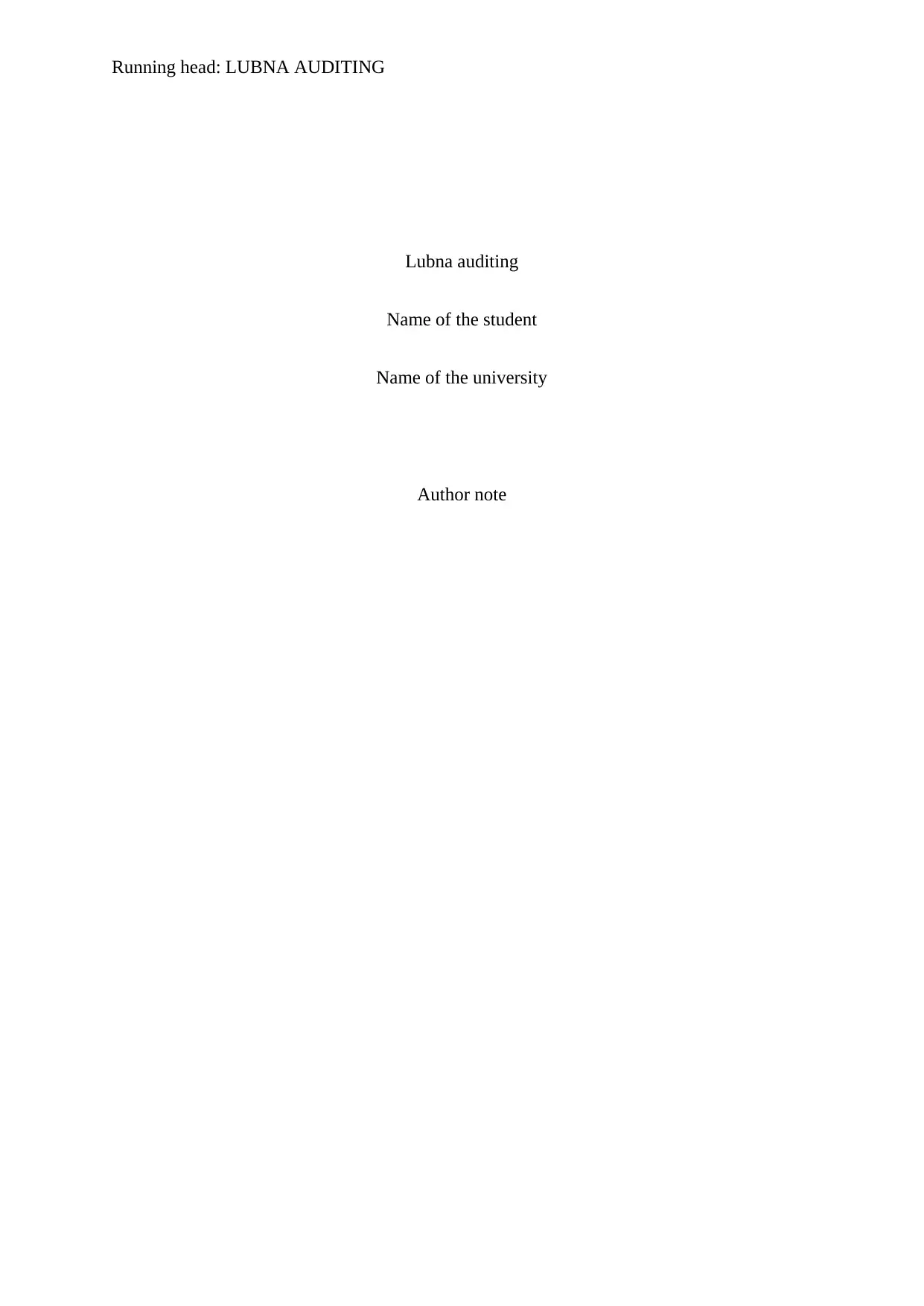
Running head: LUBNA AUDITING
Lubna auditing
Name of the student
Name of the university
Author note
Lubna auditing
Name of the student
Name of the university
Author note
Secure Best Marks with AI Grader
Need help grading? Try our AI Grader for instant feedback on your assignments.
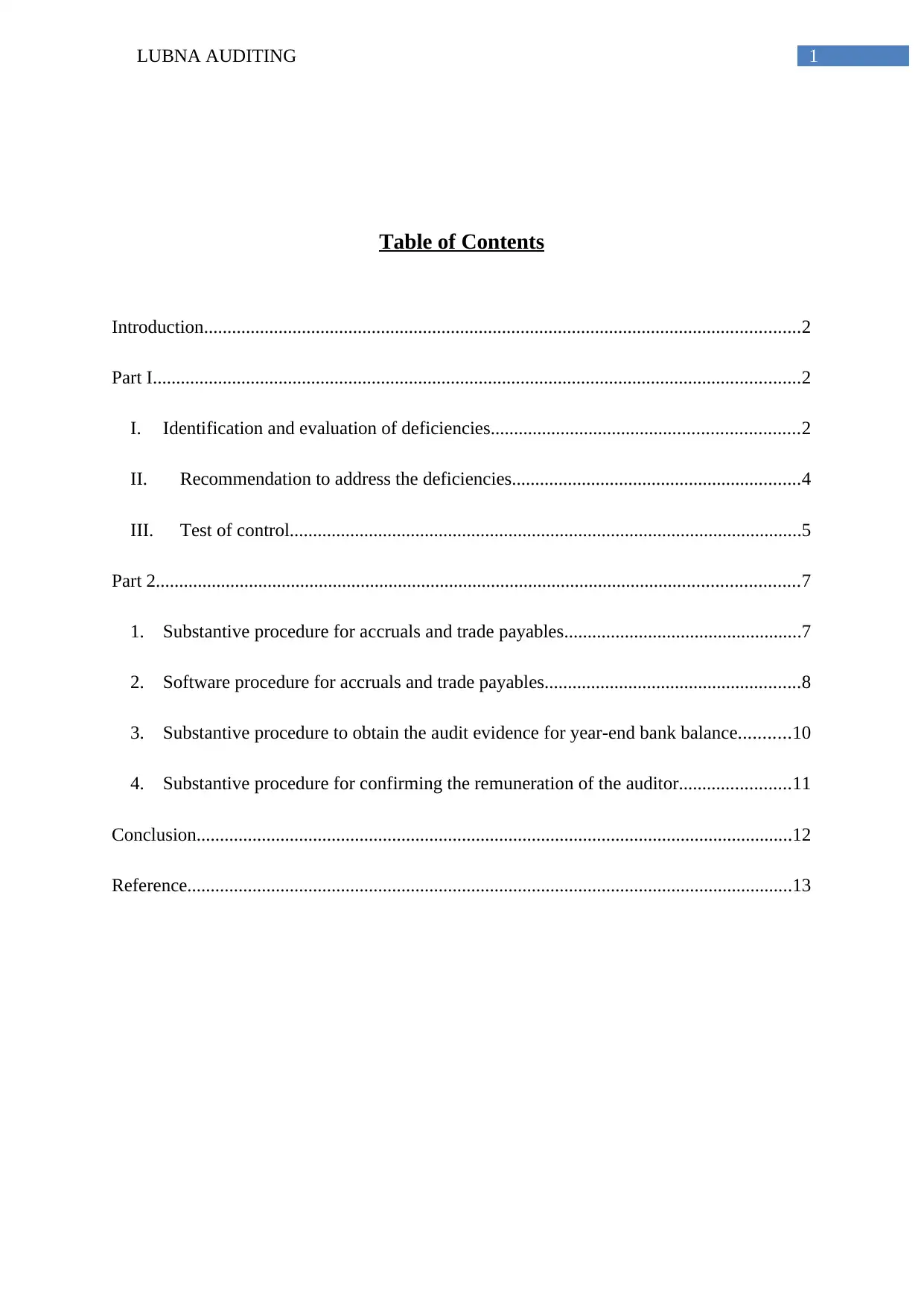
1LUBNA AUDITING
Table of Contents
Introduction................................................................................................................................2
Part I...........................................................................................................................................2
I. Identification and evaluation of deficiencies..................................................................2
II. Recommendation to address the deficiencies..............................................................4
III. Test of control..............................................................................................................5
Part 2..........................................................................................................................................7
1. Substantive procedure for accruals and trade payables...................................................7
2. Software procedure for accruals and trade payables.......................................................8
3. Substantive procedure to obtain the audit evidence for year-end bank balance...........10
4. Substantive procedure for confirming the remuneration of the auditor........................11
Conclusion................................................................................................................................12
Reference..................................................................................................................................13
Table of Contents
Introduction................................................................................................................................2
Part I...........................................................................................................................................2
I. Identification and evaluation of deficiencies..................................................................2
II. Recommendation to address the deficiencies..............................................................4
III. Test of control..............................................................................................................5
Part 2..........................................................................................................................................7
1. Substantive procedure for accruals and trade payables...................................................7
2. Software procedure for accruals and trade payables.......................................................8
3. Substantive procedure to obtain the audit evidence for year-end bank balance...........10
4. Substantive procedure for confirming the remuneration of the auditor........................11
Conclusion................................................................................................................................12
Reference..................................................................................................................................13
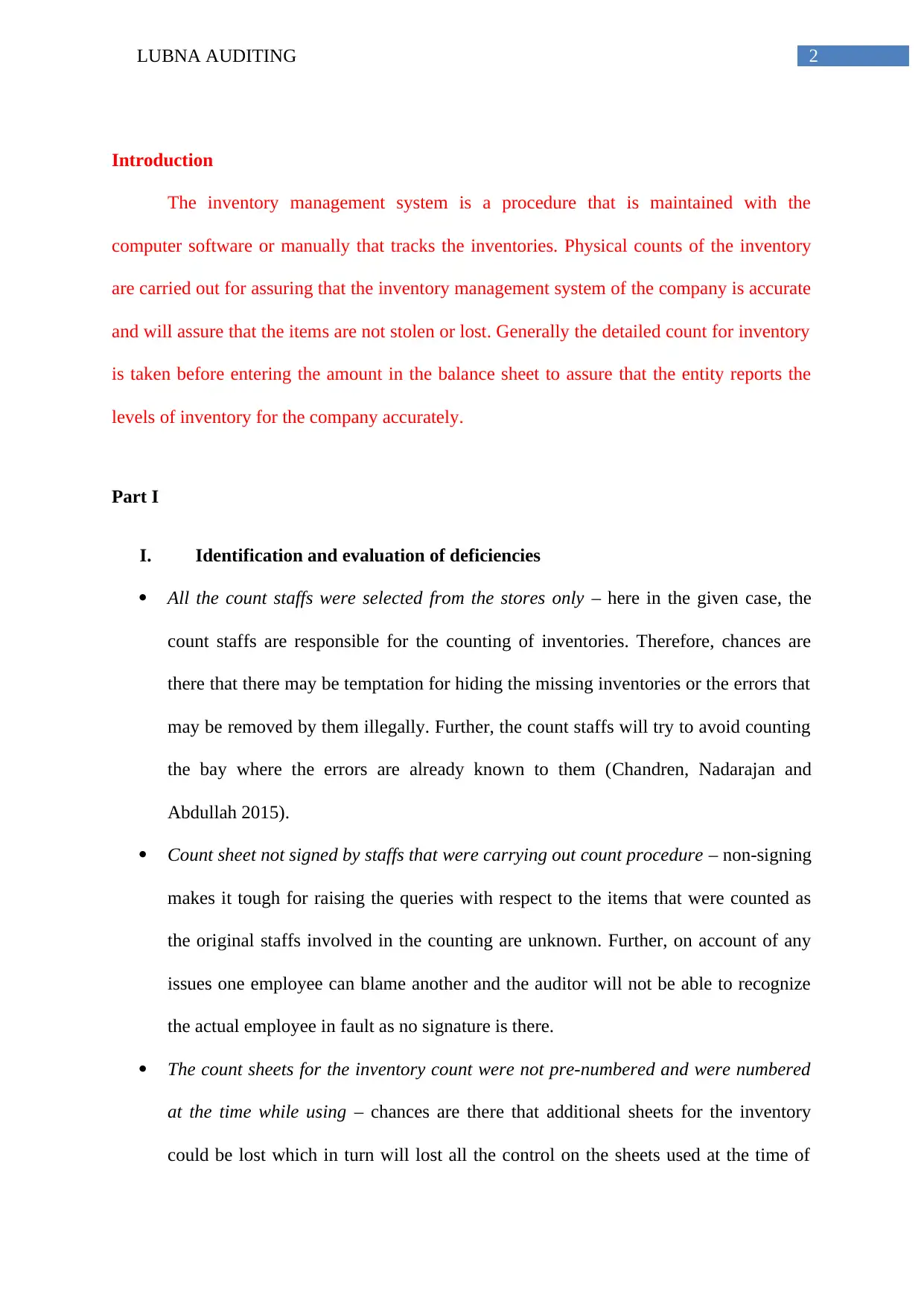
2LUBNA AUDITING
Introduction
The inventory management system is a procedure that is maintained with the
computer software or manually that tracks the inventories. Physical counts of the inventory
are carried out for assuring that the inventory management system of the company is accurate
and will assure that the items are not stolen or lost. Generally the detailed count for inventory
is taken before entering the amount in the balance sheet to assure that the entity reports the
levels of inventory for the company accurately.
Part I
I. Identification and evaluation of deficiencies
All the count staffs were selected from the stores only – here in the given case, the
count staffs are responsible for the counting of inventories. Therefore, chances are
there that there may be temptation for hiding the missing inventories or the errors that
may be removed by them illegally. Further, the count staffs will try to avoid counting
the bay where the errors are already known to them (Chandren, Nadarajan and
Abdullah 2015).
Count sheet not signed by staffs that were carrying out count procedure – non-signing
makes it tough for raising the queries with respect to the items that were counted as
the original staffs involved in the counting are unknown. Further, on account of any
issues one employee can blame another and the auditor will not be able to recognize
the actual employee in fault as no signature is there.
The count sheets for the inventory count were not pre-numbered and were numbered
at the time while using – chances are there that additional sheets for the inventory
could be lost which in turn will lost all the control on the sheets used at the time of
Introduction
The inventory management system is a procedure that is maintained with the
computer software or manually that tracks the inventories. Physical counts of the inventory
are carried out for assuring that the inventory management system of the company is accurate
and will assure that the items are not stolen or lost. Generally the detailed count for inventory
is taken before entering the amount in the balance sheet to assure that the entity reports the
levels of inventory for the company accurately.
Part I
I. Identification and evaluation of deficiencies
All the count staffs were selected from the stores only – here in the given case, the
count staffs are responsible for the counting of inventories. Therefore, chances are
there that there may be temptation for hiding the missing inventories or the errors that
may be removed by them illegally. Further, the count staffs will try to avoid counting
the bay where the errors are already known to them (Chandren, Nadarajan and
Abdullah 2015).
Count sheet not signed by staffs that were carrying out count procedure – non-signing
makes it tough for raising the queries with respect to the items that were counted as
the original staffs involved in the counting are unknown. Further, on account of any
issues one employee can blame another and the auditor will not be able to recognize
the actual employee in fault as no signature is there.
The count sheets for the inventory count were not pre-numbered and were numbered
at the time while using – chances are there that additional sheets for the inventory
could be lost which in turn will lost all the control on the sheets used at the time of
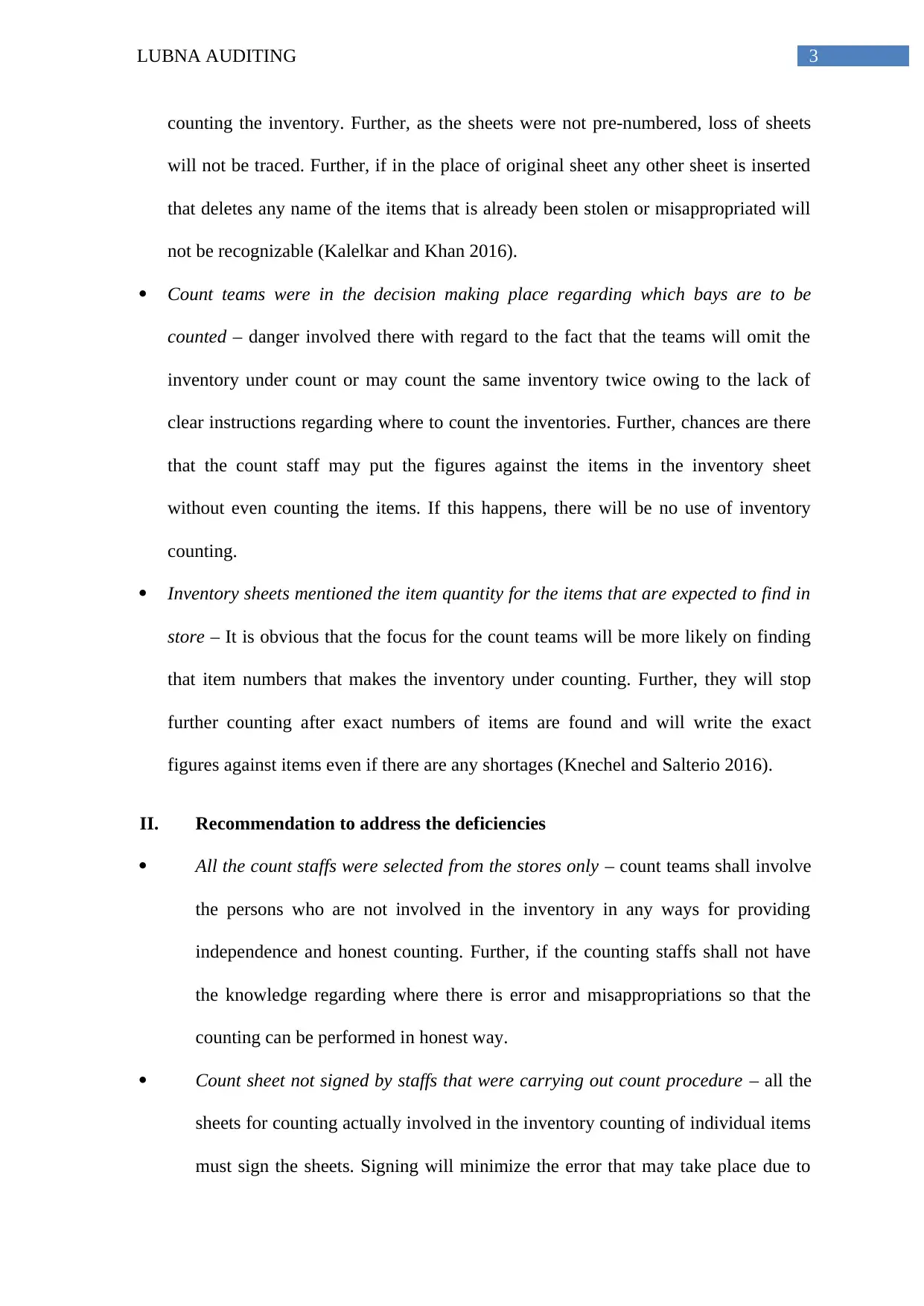
3LUBNA AUDITING
counting the inventory. Further, as the sheets were not pre-numbered, loss of sheets
will not be traced. Further, if in the place of original sheet any other sheet is inserted
that deletes any name of the items that is already been stolen or misappropriated will
not be recognizable (Kalelkar and Khan 2016).
Count teams were in the decision making place regarding which bays are to be
counted – danger involved there with regard to the fact that the teams will omit the
inventory under count or may count the same inventory twice owing to the lack of
clear instructions regarding where to count the inventories. Further, chances are there
that the count staff may put the figures against the items in the inventory sheet
without even counting the items. If this happens, there will be no use of inventory
counting.
Inventory sheets mentioned the item quantity for the items that are expected to find in
store – It is obvious that the focus for the count teams will be more likely on finding
that item numbers that makes the inventory under counting. Further, they will stop
further counting after exact numbers of items are found and will write the exact
figures against items even if there are any shortages (Knechel and Salterio 2016).
II. Recommendation to address the deficiencies
All the count staffs were selected from the stores only – count teams shall involve
the persons who are not involved in the inventory in any ways for providing
independence and honest counting. Further, if the counting staffs shall not have
the knowledge regarding where there is error and misappropriations so that the
counting can be performed in honest way.
Count sheet not signed by staffs that were carrying out count procedure – all the
sheets for counting actually involved in the inventory counting of individual items
must sign the sheets. Signing will minimize the error that may take place due to
counting the inventory. Further, as the sheets were not pre-numbered, loss of sheets
will not be traced. Further, if in the place of original sheet any other sheet is inserted
that deletes any name of the items that is already been stolen or misappropriated will
not be recognizable (Kalelkar and Khan 2016).
Count teams were in the decision making place regarding which bays are to be
counted – danger involved there with regard to the fact that the teams will omit the
inventory under count or may count the same inventory twice owing to the lack of
clear instructions regarding where to count the inventories. Further, chances are there
that the count staff may put the figures against the items in the inventory sheet
without even counting the items. If this happens, there will be no use of inventory
counting.
Inventory sheets mentioned the item quantity for the items that are expected to find in
store – It is obvious that the focus for the count teams will be more likely on finding
that item numbers that makes the inventory under counting. Further, they will stop
further counting after exact numbers of items are found and will write the exact
figures against items even if there are any shortages (Knechel and Salterio 2016).
II. Recommendation to address the deficiencies
All the count staffs were selected from the stores only – count teams shall involve
the persons who are not involved in the inventory in any ways for providing
independence and honest counting. Further, if the counting staffs shall not have
the knowledge regarding where there is error and misappropriations so that the
counting can be performed in honest way.
Count sheet not signed by staffs that were carrying out count procedure – all the
sheets for counting actually involved in the inventory counting of individual items
must sign the sheets. Signing will minimize the error that may take place due to
Secure Best Marks with AI Grader
Need help grading? Try our AI Grader for instant feedback on your assignments.
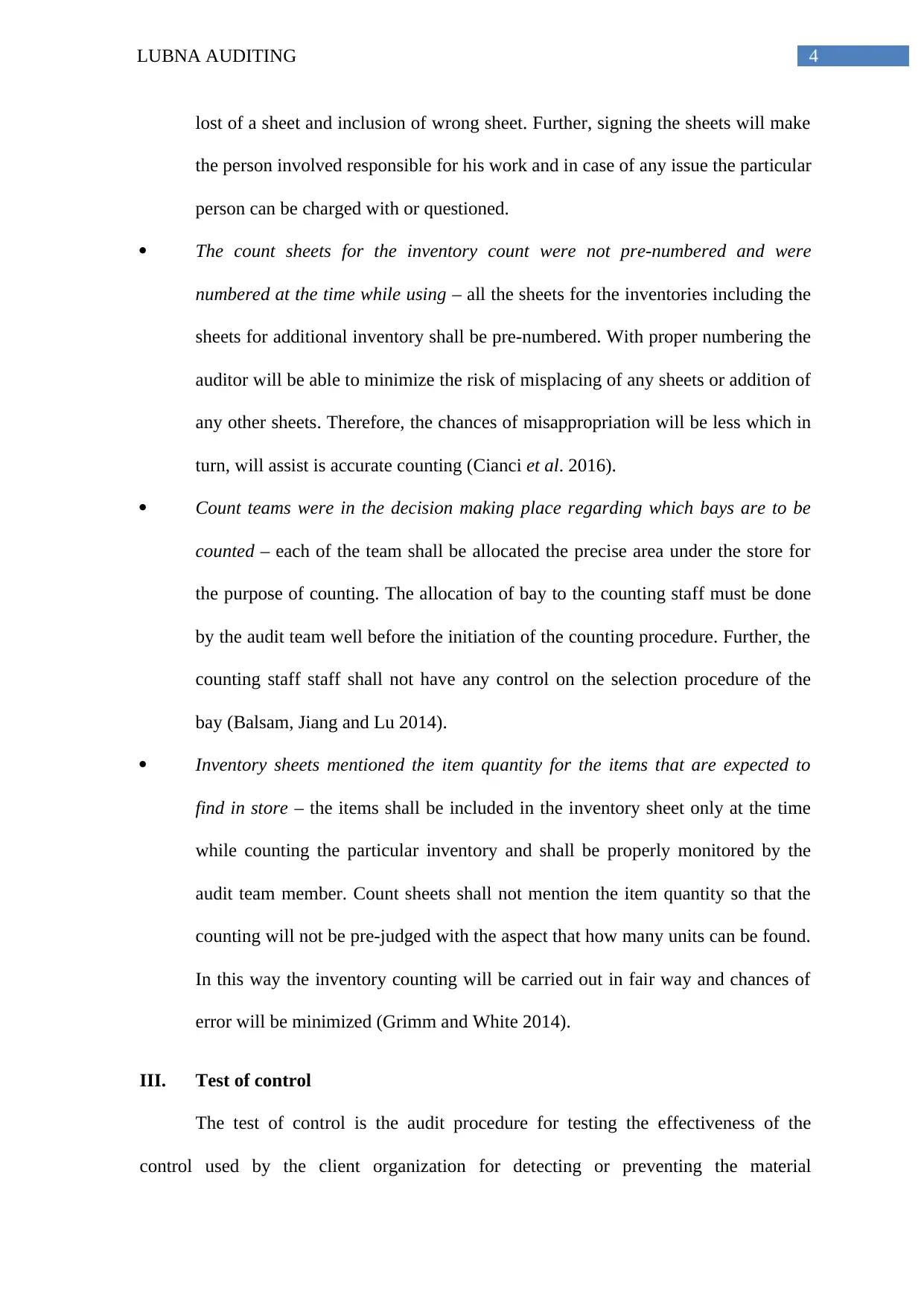
4LUBNA AUDITING
lost of a sheet and inclusion of wrong sheet. Further, signing the sheets will make
the person involved responsible for his work and in case of any issue the particular
person can be charged with or questioned.
The count sheets for the inventory count were not pre-numbered and were
numbered at the time while using – all the sheets for the inventories including the
sheets for additional inventory shall be pre-numbered. With proper numbering the
auditor will be able to minimize the risk of misplacing of any sheets or addition of
any other sheets. Therefore, the chances of misappropriation will be less which in
turn, will assist is accurate counting (Cianci et al. 2016).
Count teams were in the decision making place regarding which bays are to be
counted – each of the team shall be allocated the precise area under the store for
the purpose of counting. The allocation of bay to the counting staff must be done
by the audit team well before the initiation of the counting procedure. Further, the
counting staff staff shall not have any control on the selection procedure of the
bay (Balsam, Jiang and Lu 2014).
Inventory sheets mentioned the item quantity for the items that are expected to
find in store – the items shall be included in the inventory sheet only at the time
while counting the particular inventory and shall be properly monitored by the
audit team member. Count sheets shall not mention the item quantity so that the
counting will not be pre-judged with the aspect that how many units can be found.
In this way the inventory counting will be carried out in fair way and chances of
error will be minimized (Grimm and White 2014).
III. Test of control
The test of control is the audit procedure for testing the effectiveness of the
control used by the client organization for detecting or preventing the material
lost of a sheet and inclusion of wrong sheet. Further, signing the sheets will make
the person involved responsible for his work and in case of any issue the particular
person can be charged with or questioned.
The count sheets for the inventory count were not pre-numbered and were
numbered at the time while using – all the sheets for the inventories including the
sheets for additional inventory shall be pre-numbered. With proper numbering the
auditor will be able to minimize the risk of misplacing of any sheets or addition of
any other sheets. Therefore, the chances of misappropriation will be less which in
turn, will assist is accurate counting (Cianci et al. 2016).
Count teams were in the decision making place regarding which bays are to be
counted – each of the team shall be allocated the precise area under the store for
the purpose of counting. The allocation of bay to the counting staff must be done
by the audit team well before the initiation of the counting procedure. Further, the
counting staff staff shall not have any control on the selection procedure of the
bay (Balsam, Jiang and Lu 2014).
Inventory sheets mentioned the item quantity for the items that are expected to
find in store – the items shall be included in the inventory sheet only at the time
while counting the particular inventory and shall be properly monitored by the
audit team member. Count sheets shall not mention the item quantity so that the
counting will not be pre-judged with the aspect that how many units can be found.
In this way the inventory counting will be carried out in fair way and chances of
error will be minimized (Grimm and White 2014).
III. Test of control
The test of control is the audit procedure for testing the effectiveness of the
control used by the client organization for detecting or preventing the material
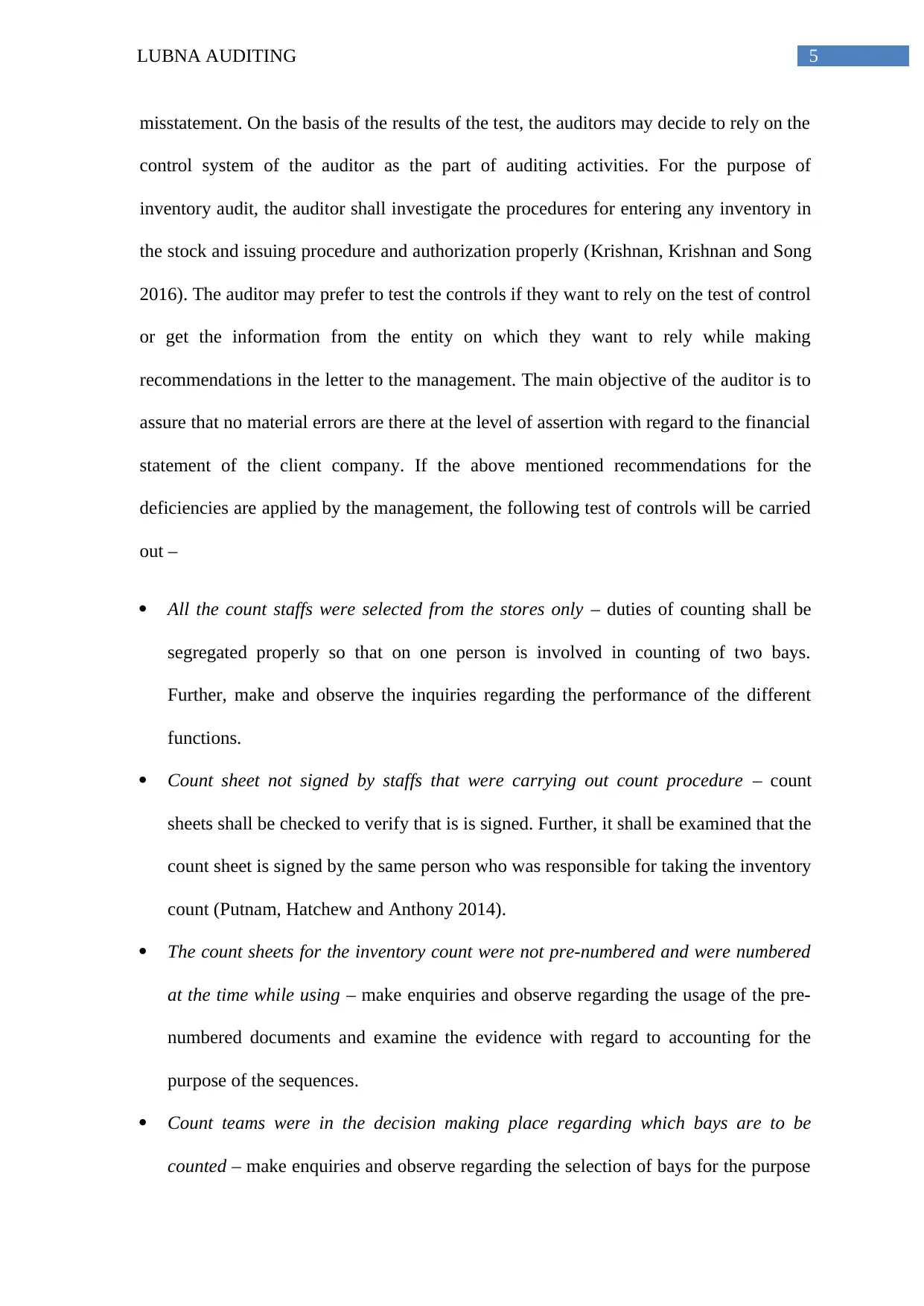
5LUBNA AUDITING
misstatement. On the basis of the results of the test, the auditors may decide to rely on the
control system of the auditor as the part of auditing activities. For the purpose of
inventory audit, the auditor shall investigate the procedures for entering any inventory in
the stock and issuing procedure and authorization properly (Krishnan, Krishnan and Song
2016). The auditor may prefer to test the controls if they want to rely on the test of control
or get the information from the entity on which they want to rely while making
recommendations in the letter to the management. The main objective of the auditor is to
assure that no material errors are there at the level of assertion with regard to the financial
statement of the client company. If the above mentioned recommendations for the
deficiencies are applied by the management, the following test of controls will be carried
out –
All the count staffs were selected from the stores only – duties of counting shall be
segregated properly so that on one person is involved in counting of two bays.
Further, make and observe the inquiries regarding the performance of the different
functions.
Count sheet not signed by staffs that were carrying out count procedure – count
sheets shall be checked to verify that is is signed. Further, it shall be examined that the
count sheet is signed by the same person who was responsible for taking the inventory
count (Putnam, Hatchew and Anthony 2014).
The count sheets for the inventory count were not pre-numbered and were numbered
at the time while using – make enquiries and observe regarding the usage of the pre-
numbered documents and examine the evidence with regard to accounting for the
purpose of the sequences.
Count teams were in the decision making place regarding which bays are to be
counted – make enquiries and observe regarding the selection of bays for the purpose
misstatement. On the basis of the results of the test, the auditors may decide to rely on the
control system of the auditor as the part of auditing activities. For the purpose of
inventory audit, the auditor shall investigate the procedures for entering any inventory in
the stock and issuing procedure and authorization properly (Krishnan, Krishnan and Song
2016). The auditor may prefer to test the controls if they want to rely on the test of control
or get the information from the entity on which they want to rely while making
recommendations in the letter to the management. The main objective of the auditor is to
assure that no material errors are there at the level of assertion with regard to the financial
statement of the client company. If the above mentioned recommendations for the
deficiencies are applied by the management, the following test of controls will be carried
out –
All the count staffs were selected from the stores only – duties of counting shall be
segregated properly so that on one person is involved in counting of two bays.
Further, make and observe the inquiries regarding the performance of the different
functions.
Count sheet not signed by staffs that were carrying out count procedure – count
sheets shall be checked to verify that is is signed. Further, it shall be examined that the
count sheet is signed by the same person who was responsible for taking the inventory
count (Putnam, Hatchew and Anthony 2014).
The count sheets for the inventory count were not pre-numbered and were numbered
at the time while using – make enquiries and observe regarding the usage of the pre-
numbered documents and examine the evidence with regard to accounting for the
purpose of the sequences.
Count teams were in the decision making place regarding which bays are to be
counted – make enquiries and observe regarding the selection of bays for the purpose
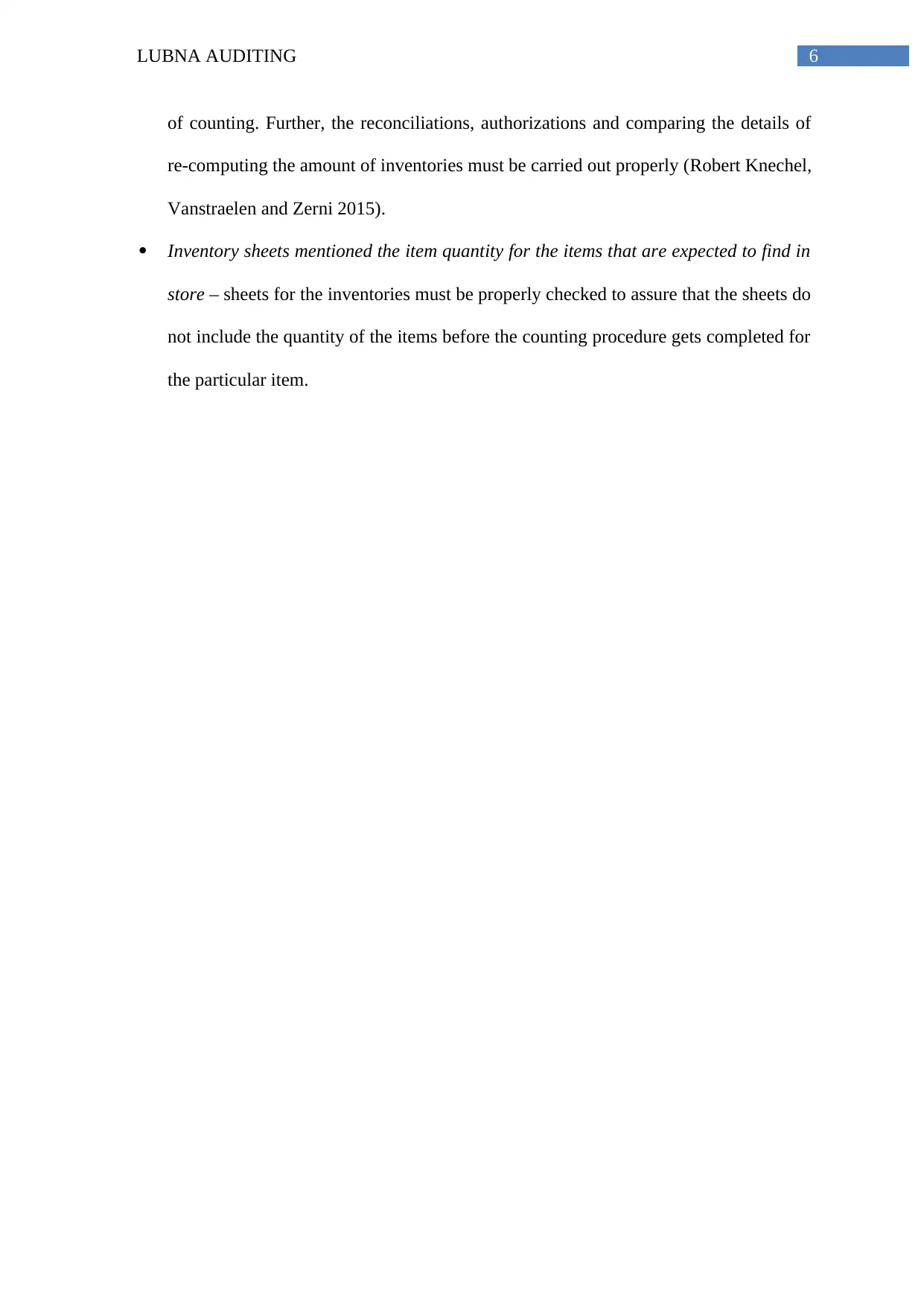
6LUBNA AUDITING
of counting. Further, the reconciliations, authorizations and comparing the details of
re-computing the amount of inventories must be carried out properly (Robert Knechel,
Vanstraelen and Zerni 2015).
Inventory sheets mentioned the item quantity for the items that are expected to find in
store – sheets for the inventories must be properly checked to assure that the sheets do
not include the quantity of the items before the counting procedure gets completed for
the particular item.
of counting. Further, the reconciliations, authorizations and comparing the details of
re-computing the amount of inventories must be carried out properly (Robert Knechel,
Vanstraelen and Zerni 2015).
Inventory sheets mentioned the item quantity for the items that are expected to find in
store – sheets for the inventories must be properly checked to assure that the sheets do
not include the quantity of the items before the counting procedure gets completed for
the particular item.
Paraphrase This Document
Need a fresh take? Get an instant paraphrase of this document with our AI Paraphraser
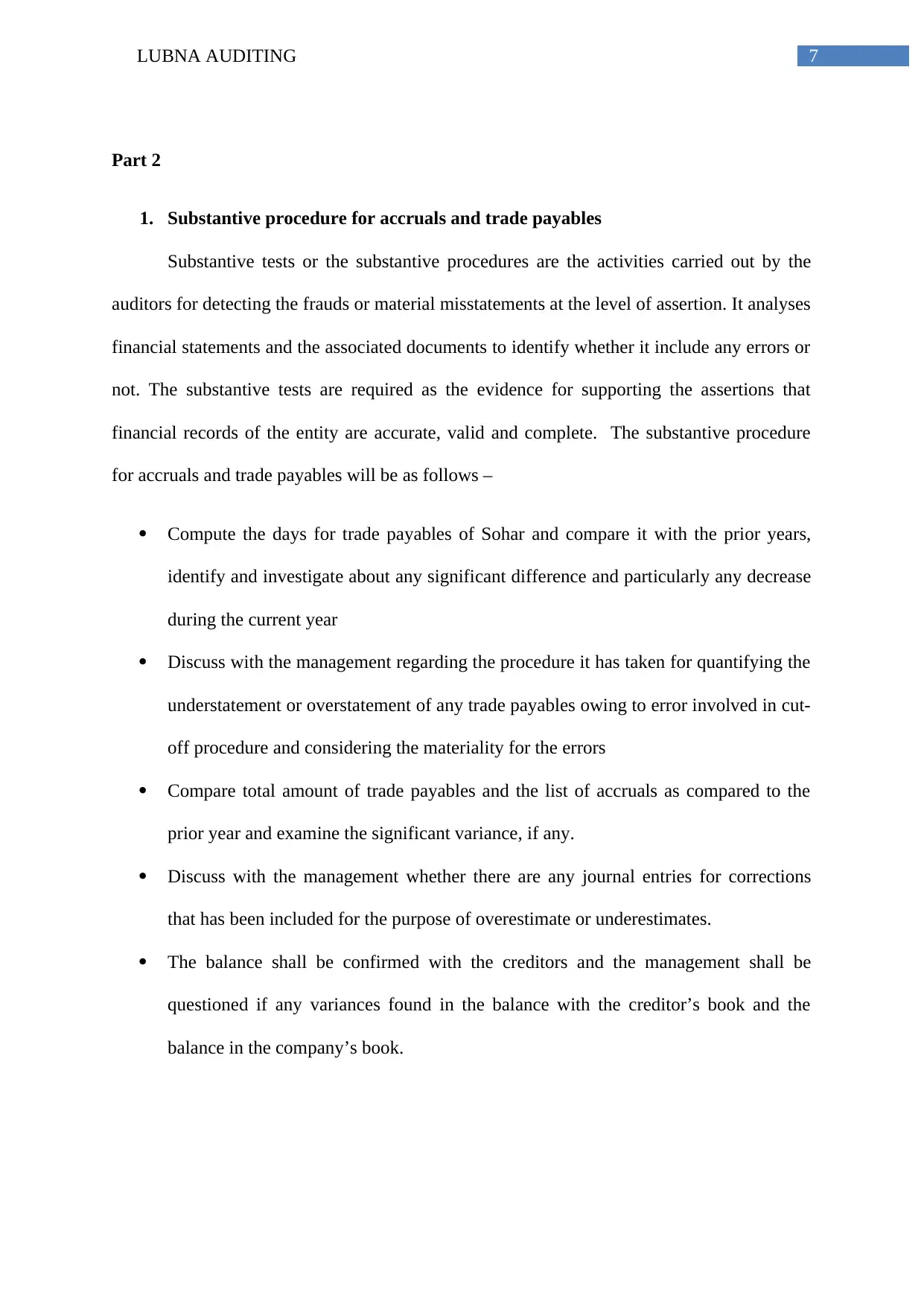
7LUBNA AUDITING
Part 2
1. Substantive procedure for accruals and trade payables
Substantive tests or the substantive procedures are the activities carried out by the
auditors for detecting the frauds or material misstatements at the level of assertion. It analyses
financial statements and the associated documents to identify whether it include any errors or
not. The substantive tests are required as the evidence for supporting the assertions that
financial records of the entity are accurate, valid and complete. The substantive procedure
for accruals and trade payables will be as follows –
Compute the days for trade payables of Sohar and compare it with the prior years,
identify and investigate about any significant difference and particularly any decrease
during the current year
Discuss with the management regarding the procedure it has taken for quantifying the
understatement or overstatement of any trade payables owing to error involved in cut-
off procedure and considering the materiality for the errors
Compare total amount of trade payables and the list of accruals as compared to the
prior year and examine the significant variance, if any.
Discuss with the management whether there are any journal entries for corrections
that has been included for the purpose of overestimate or underestimates.
The balance shall be confirmed with the creditors and the management shall be
questioned if any variances found in the balance with the creditor’s book and the
balance in the company’s book.
Part 2
1. Substantive procedure for accruals and trade payables
Substantive tests or the substantive procedures are the activities carried out by the
auditors for detecting the frauds or material misstatements at the level of assertion. It analyses
financial statements and the associated documents to identify whether it include any errors or
not. The substantive tests are required as the evidence for supporting the assertions that
financial records of the entity are accurate, valid and complete. The substantive procedure
for accruals and trade payables will be as follows –
Compute the days for trade payables of Sohar and compare it with the prior years,
identify and investigate about any significant difference and particularly any decrease
during the current year
Discuss with the management regarding the procedure it has taken for quantifying the
understatement or overstatement of any trade payables owing to error involved in cut-
off procedure and considering the materiality for the errors
Compare total amount of trade payables and the list of accruals as compared to the
prior year and examine the significant variance, if any.
Discuss with the management whether there are any journal entries for corrections
that has been included for the purpose of overestimate or underestimates.
The balance shall be confirmed with the creditors and the management shall be
questioned if any variances found in the balance with the creditor’s book and the
balance in the company’s book.
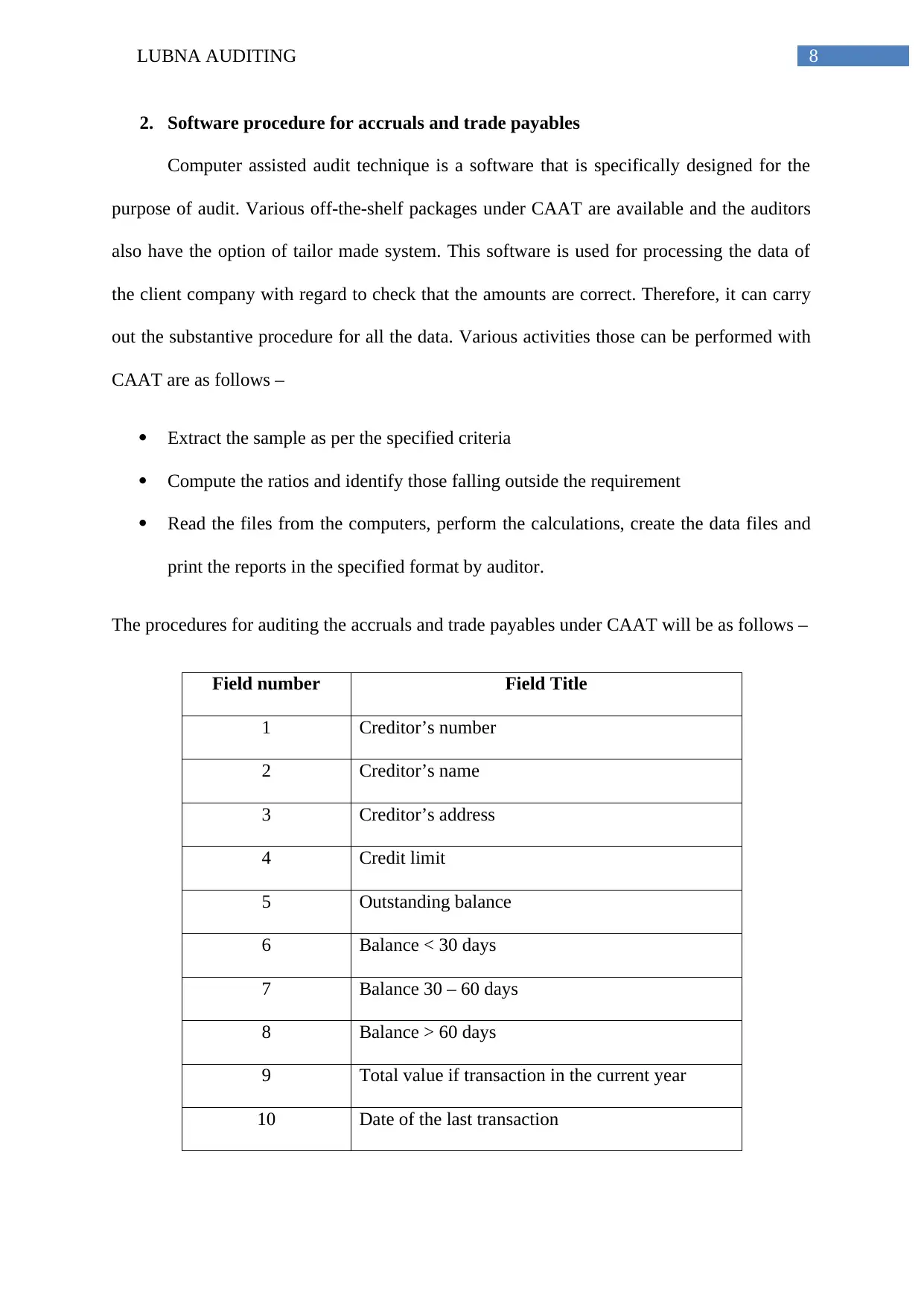
8LUBNA AUDITING
2. Software procedure for accruals and trade payables
Computer assisted audit technique is a software that is specifically designed for the
purpose of audit. Various off-the-shelf packages under CAAT are available and the auditors
also have the option of tailor made system. This software is used for processing the data of
the client company with regard to check that the amounts are correct. Therefore, it can carry
out the substantive procedure for all the data. Various activities those can be performed with
CAAT are as follows –
Extract the sample as per the specified criteria
Compute the ratios and identify those falling outside the requirement
Read the files from the computers, perform the calculations, create the data files and
print the reports in the specified format by auditor.
The procedures for auditing the accruals and trade payables under CAAT will be as follows –
Field number Field Title
1 Creditor’s number
2 Creditor’s name
3 Creditor’s address
4 Credit limit
5 Outstanding balance
6 Balance < 30 days
7 Balance 30 – 60 days
8 Balance > 60 days
9 Total value if transaction in the current year
10 Date of the last transaction
2. Software procedure for accruals and trade payables
Computer assisted audit technique is a software that is specifically designed for the
purpose of audit. Various off-the-shelf packages under CAAT are available and the auditors
also have the option of tailor made system. This software is used for processing the data of
the client company with regard to check that the amounts are correct. Therefore, it can carry
out the substantive procedure for all the data. Various activities those can be performed with
CAAT are as follows –
Extract the sample as per the specified criteria
Compute the ratios and identify those falling outside the requirement
Read the files from the computers, perform the calculations, create the data files and
print the reports in the specified format by auditor.
The procedures for auditing the accruals and trade payables under CAAT will be as follows –
Field number Field Title
1 Creditor’s number
2 Creditor’s name
3 Creditor’s address
4 Credit limit
5 Outstanding balance
6 Balance < 30 days
7 Balance 30 – 60 days
8 Balance > 60 days
9 Total value if transaction in the current year
10 Date of the last transaction
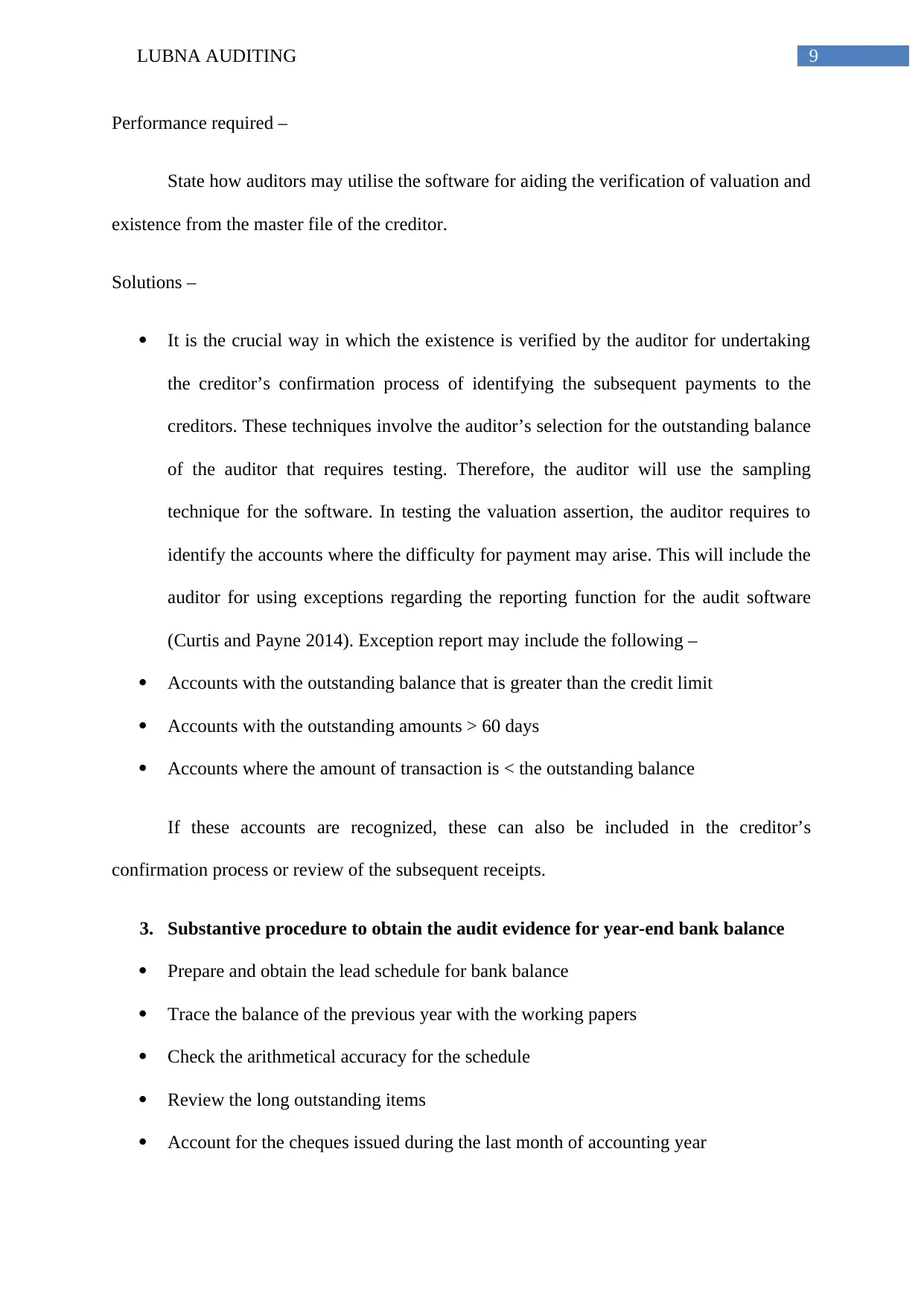
9LUBNA AUDITING
Performance required –
State how auditors may utilise the software for aiding the verification of valuation and
existence from the master file of the creditor.
Solutions –
It is the crucial way in which the existence is verified by the auditor for undertaking
the creditor’s confirmation process of identifying the subsequent payments to the
creditors. These techniques involve the auditor’s selection for the outstanding balance
of the auditor that requires testing. Therefore, the auditor will use the sampling
technique for the software. In testing the valuation assertion, the auditor requires to
identify the accounts where the difficulty for payment may arise. This will include the
auditor for using exceptions regarding the reporting function for the audit software
(Curtis and Payne 2014). Exception report may include the following –
Accounts with the outstanding balance that is greater than the credit limit
Accounts with the outstanding amounts > 60 days
Accounts where the amount of transaction is < the outstanding balance
If these accounts are recognized, these can also be included in the creditor’s
confirmation process or review of the subsequent receipts.
3. Substantive procedure to obtain the audit evidence for year-end bank balance
Prepare and obtain the lead schedule for bank balance
Trace the balance of the previous year with the working papers
Check the arithmetical accuracy for the schedule
Review the long outstanding items
Account for the cheques issued during the last month of accounting year
Performance required –
State how auditors may utilise the software for aiding the verification of valuation and
existence from the master file of the creditor.
Solutions –
It is the crucial way in which the existence is verified by the auditor for undertaking
the creditor’s confirmation process of identifying the subsequent payments to the
creditors. These techniques involve the auditor’s selection for the outstanding balance
of the auditor that requires testing. Therefore, the auditor will use the sampling
technique for the software. In testing the valuation assertion, the auditor requires to
identify the accounts where the difficulty for payment may arise. This will include the
auditor for using exceptions regarding the reporting function for the audit software
(Curtis and Payne 2014). Exception report may include the following –
Accounts with the outstanding balance that is greater than the credit limit
Accounts with the outstanding amounts > 60 days
Accounts where the amount of transaction is < the outstanding balance
If these accounts are recognized, these can also be included in the creditor’s
confirmation process or review of the subsequent receipts.
3. Substantive procedure to obtain the audit evidence for year-end bank balance
Prepare and obtain the lead schedule for bank balance
Trace the balance of the previous year with the working papers
Check the arithmetical accuracy for the schedule
Review the long outstanding items
Account for the cheques issued during the last month of accounting year
Secure Best Marks with AI Grader
Need help grading? Try our AI Grader for instant feedback on your assignments.
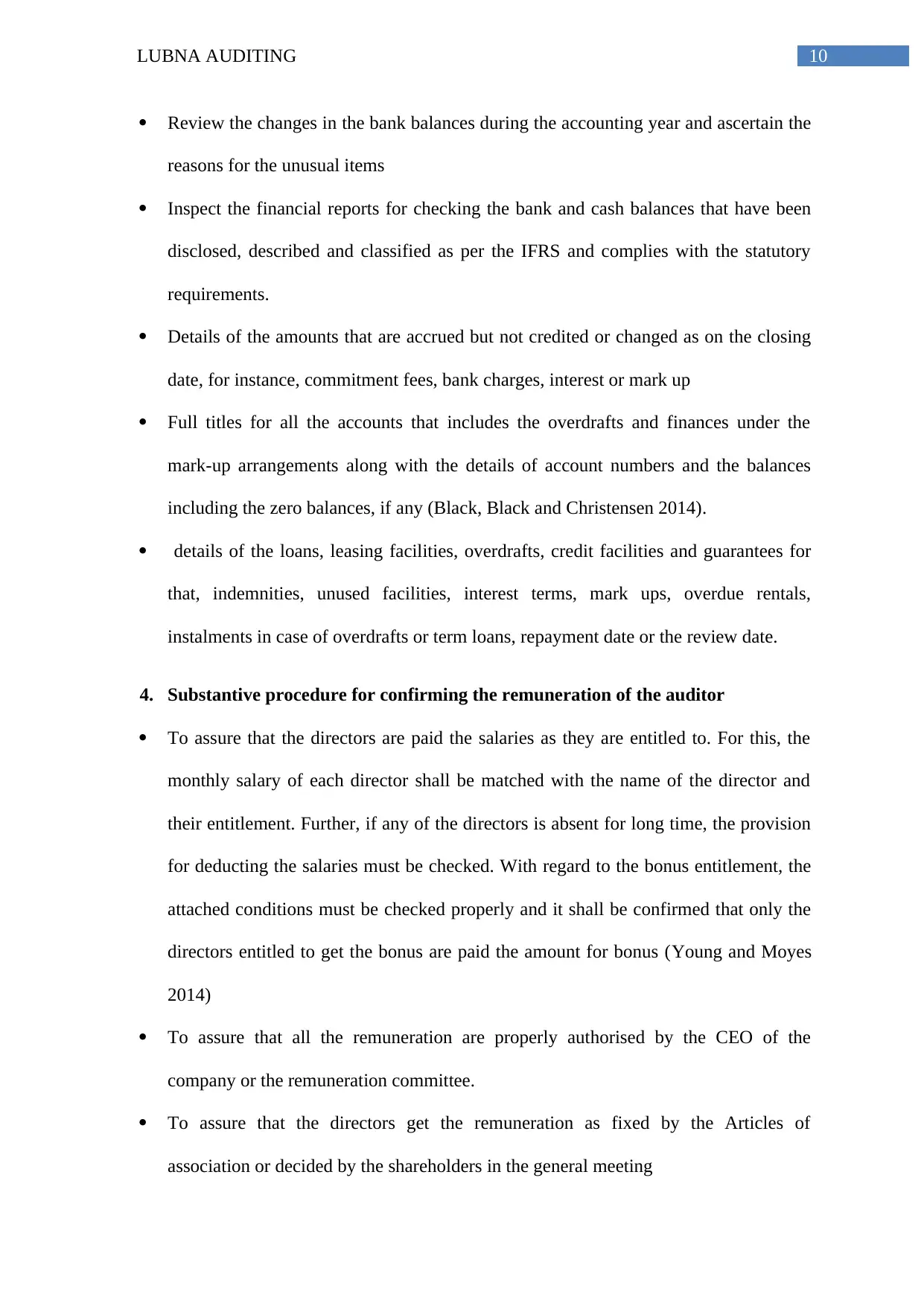
10LUBNA AUDITING
Review the changes in the bank balances during the accounting year and ascertain the
reasons for the unusual items
Inspect the financial reports for checking the bank and cash balances that have been
disclosed, described and classified as per the IFRS and complies with the statutory
requirements.
Details of the amounts that are accrued but not credited or changed as on the closing
date, for instance, commitment fees, bank charges, interest or mark up
Full titles for all the accounts that includes the overdrafts and finances under the
mark-up arrangements along with the details of account numbers and the balances
including the zero balances, if any (Black, Black and Christensen 2014).
details of the loans, leasing facilities, overdrafts, credit facilities and guarantees for
that, indemnities, unused facilities, interest terms, mark ups, overdue rentals,
instalments in case of overdrafts or term loans, repayment date or the review date.
4. Substantive procedure for confirming the remuneration of the auditor
To assure that the directors are paid the salaries as they are entitled to. For this, the
monthly salary of each director shall be matched with the name of the director and
their entitlement. Further, if any of the directors is absent for long time, the provision
for deducting the salaries must be checked. With regard to the bonus entitlement, the
attached conditions must be checked properly and it shall be confirmed that only the
directors entitled to get the bonus are paid the amount for bonus (Young and Moyes
2014)
To assure that all the remuneration are properly authorised by the CEO of the
company or the remuneration committee.
To assure that the directors get the remuneration as fixed by the Articles of
association or decided by the shareholders in the general meeting
Review the changes in the bank balances during the accounting year and ascertain the
reasons for the unusual items
Inspect the financial reports for checking the bank and cash balances that have been
disclosed, described and classified as per the IFRS and complies with the statutory
requirements.
Details of the amounts that are accrued but not credited or changed as on the closing
date, for instance, commitment fees, bank charges, interest or mark up
Full titles for all the accounts that includes the overdrafts and finances under the
mark-up arrangements along with the details of account numbers and the balances
including the zero balances, if any (Black, Black and Christensen 2014).
details of the loans, leasing facilities, overdrafts, credit facilities and guarantees for
that, indemnities, unused facilities, interest terms, mark ups, overdue rentals,
instalments in case of overdrafts or term loans, repayment date or the review date.
4. Substantive procedure for confirming the remuneration of the auditor
To assure that the directors are paid the salaries as they are entitled to. For this, the
monthly salary of each director shall be matched with the name of the director and
their entitlement. Further, if any of the directors is absent for long time, the provision
for deducting the salaries must be checked. With regard to the bonus entitlement, the
attached conditions must be checked properly and it shall be confirmed that only the
directors entitled to get the bonus are paid the amount for bonus (Young and Moyes
2014)
To assure that all the remuneration are properly authorised by the CEO of the
company or the remuneration committee.
To assure that the directors get the remuneration as fixed by the Articles of
association or decided by the shareholders in the general meeting
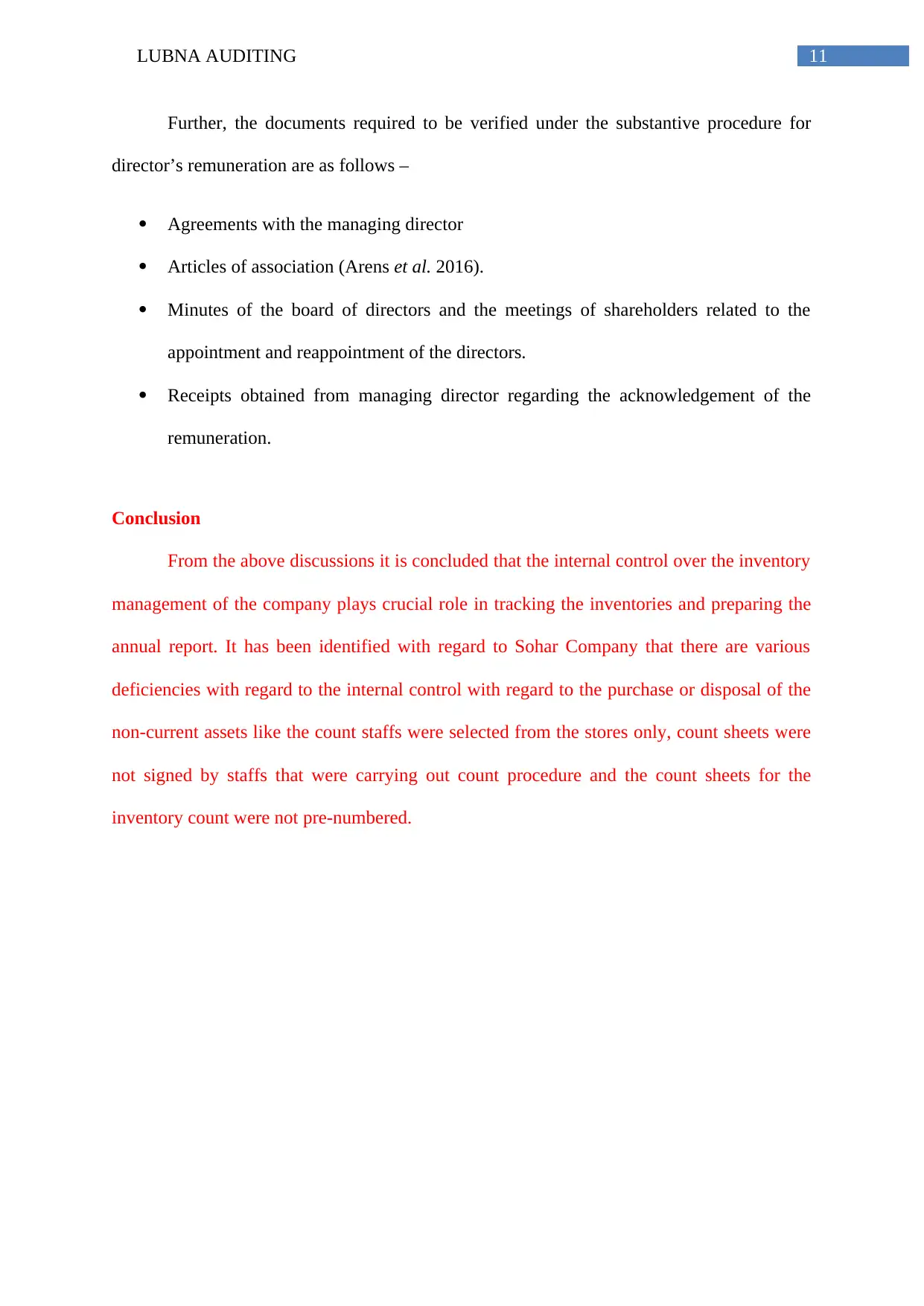
11LUBNA AUDITING
Further, the documents required to be verified under the substantive procedure for
director’s remuneration are as follows –
Agreements with the managing director
Articles of association (Arens et al. 2016).
Minutes of the board of directors and the meetings of shareholders related to the
appointment and reappointment of the directors.
Receipts obtained from managing director regarding the acknowledgement of the
remuneration.
Conclusion
From the above discussions it is concluded that the internal control over the inventory
management of the company plays crucial role in tracking the inventories and preparing the
annual report. It has been identified with regard to Sohar Company that there are various
deficiencies with regard to the internal control with regard to the purchase or disposal of the
non-current assets like the count staffs were selected from the stores only, count sheets were
not signed by staffs that were carrying out count procedure and the count sheets for the
inventory count were not pre-numbered.
Further, the documents required to be verified under the substantive procedure for
director’s remuneration are as follows –
Agreements with the managing director
Articles of association (Arens et al. 2016).
Minutes of the board of directors and the meetings of shareholders related to the
appointment and reappointment of the directors.
Receipts obtained from managing director regarding the acknowledgement of the
remuneration.
Conclusion
From the above discussions it is concluded that the internal control over the inventory
management of the company plays crucial role in tracking the inventories and preparing the
annual report. It has been identified with regard to Sohar Company that there are various
deficiencies with regard to the internal control with regard to the purchase or disposal of the
non-current assets like the count staffs were selected from the stores only, count sheets were
not signed by staffs that were carrying out count procedure and the count sheets for the
inventory count were not pre-numbered.
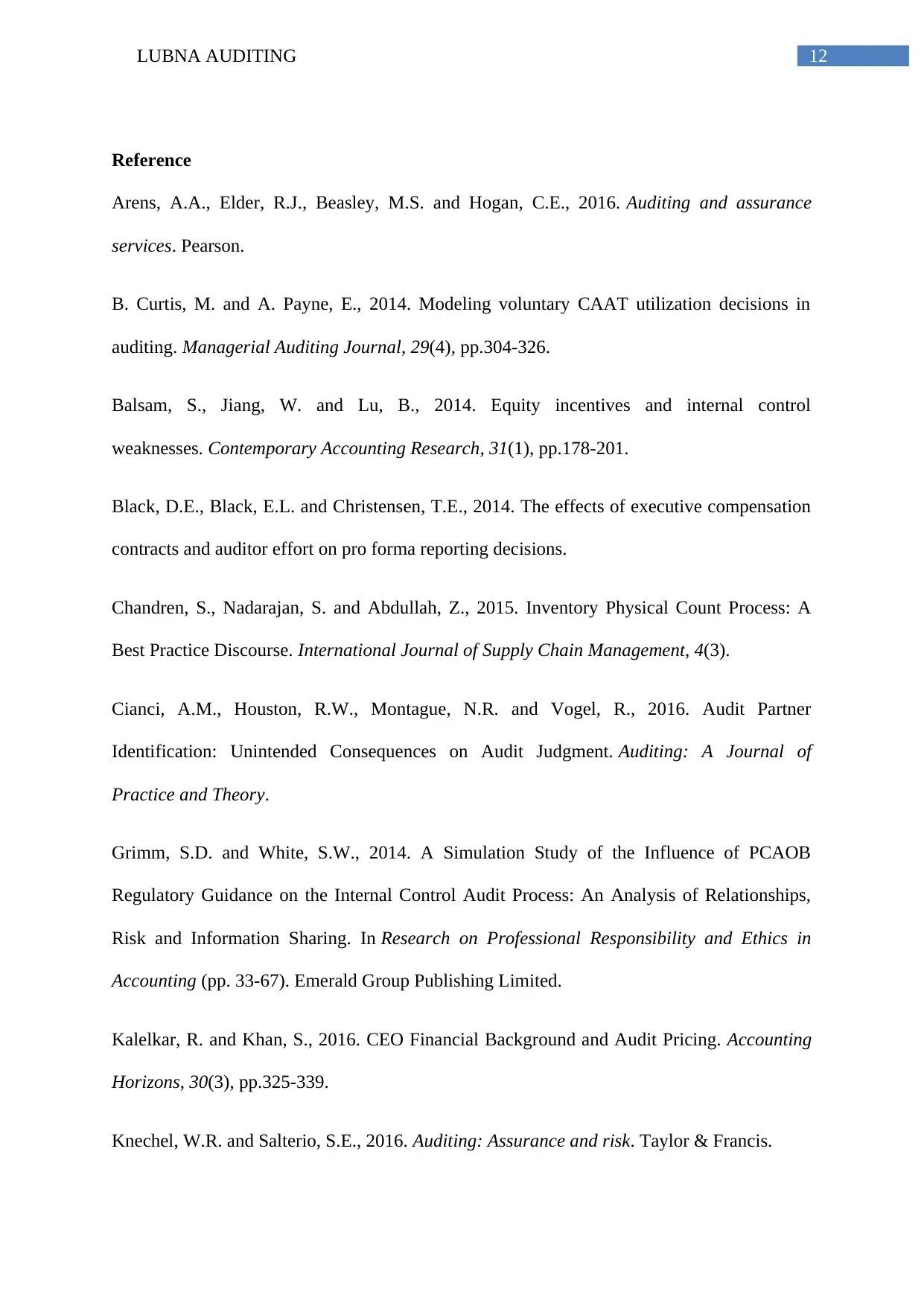
12LUBNA AUDITING
Reference
Arens, A.A., Elder, R.J., Beasley, M.S. and Hogan, C.E., 2016. Auditing and assurance
services. Pearson.
B. Curtis, M. and A. Payne, E., 2014. Modeling voluntary CAAT utilization decisions in
auditing. Managerial Auditing Journal, 29(4), pp.304-326.
Balsam, S., Jiang, W. and Lu, B., 2014. Equity incentives and internal control
weaknesses. Contemporary Accounting Research, 31(1), pp.178-201.
Black, D.E., Black, E.L. and Christensen, T.E., 2014. The effects of executive compensation
contracts and auditor effort on pro forma reporting decisions.
Chandren, S., Nadarajan, S. and Abdullah, Z., 2015. Inventory Physical Count Process: A
Best Practice Discourse. International Journal of Supply Chain Management, 4(3).
Cianci, A.M., Houston, R.W., Montague, N.R. and Vogel, R., 2016. Audit Partner
Identification: Unintended Consequences on Audit Judgment. Auditing: A Journal of
Practice and Theory.
Grimm, S.D. and White, S.W., 2014. A Simulation Study of the Influence of PCAOB
Regulatory Guidance on the Internal Control Audit Process: An Analysis of Relationships,
Risk and Information Sharing. In Research on Professional Responsibility and Ethics in
Accounting (pp. 33-67). Emerald Group Publishing Limited.
Kalelkar, R. and Khan, S., 2016. CEO Financial Background and Audit Pricing. Accounting
Horizons, 30(3), pp.325-339.
Knechel, W.R. and Salterio, S.E., 2016. Auditing: Assurance and risk. Taylor & Francis.
Reference
Arens, A.A., Elder, R.J., Beasley, M.S. and Hogan, C.E., 2016. Auditing and assurance
services. Pearson.
B. Curtis, M. and A. Payne, E., 2014. Modeling voluntary CAAT utilization decisions in
auditing. Managerial Auditing Journal, 29(4), pp.304-326.
Balsam, S., Jiang, W. and Lu, B., 2014. Equity incentives and internal control
weaknesses. Contemporary Accounting Research, 31(1), pp.178-201.
Black, D.E., Black, E.L. and Christensen, T.E., 2014. The effects of executive compensation
contracts and auditor effort on pro forma reporting decisions.
Chandren, S., Nadarajan, S. and Abdullah, Z., 2015. Inventory Physical Count Process: A
Best Practice Discourse. International Journal of Supply Chain Management, 4(3).
Cianci, A.M., Houston, R.W., Montague, N.R. and Vogel, R., 2016. Audit Partner
Identification: Unintended Consequences on Audit Judgment. Auditing: A Journal of
Practice and Theory.
Grimm, S.D. and White, S.W., 2014. A Simulation Study of the Influence of PCAOB
Regulatory Guidance on the Internal Control Audit Process: An Analysis of Relationships,
Risk and Information Sharing. In Research on Professional Responsibility and Ethics in
Accounting (pp. 33-67). Emerald Group Publishing Limited.
Kalelkar, R. and Khan, S., 2016. CEO Financial Background and Audit Pricing. Accounting
Horizons, 30(3), pp.325-339.
Knechel, W.R. and Salterio, S.E., 2016. Auditing: Assurance and risk. Taylor & Francis.
Paraphrase This Document
Need a fresh take? Get an instant paraphrase of this document with our AI Paraphraser
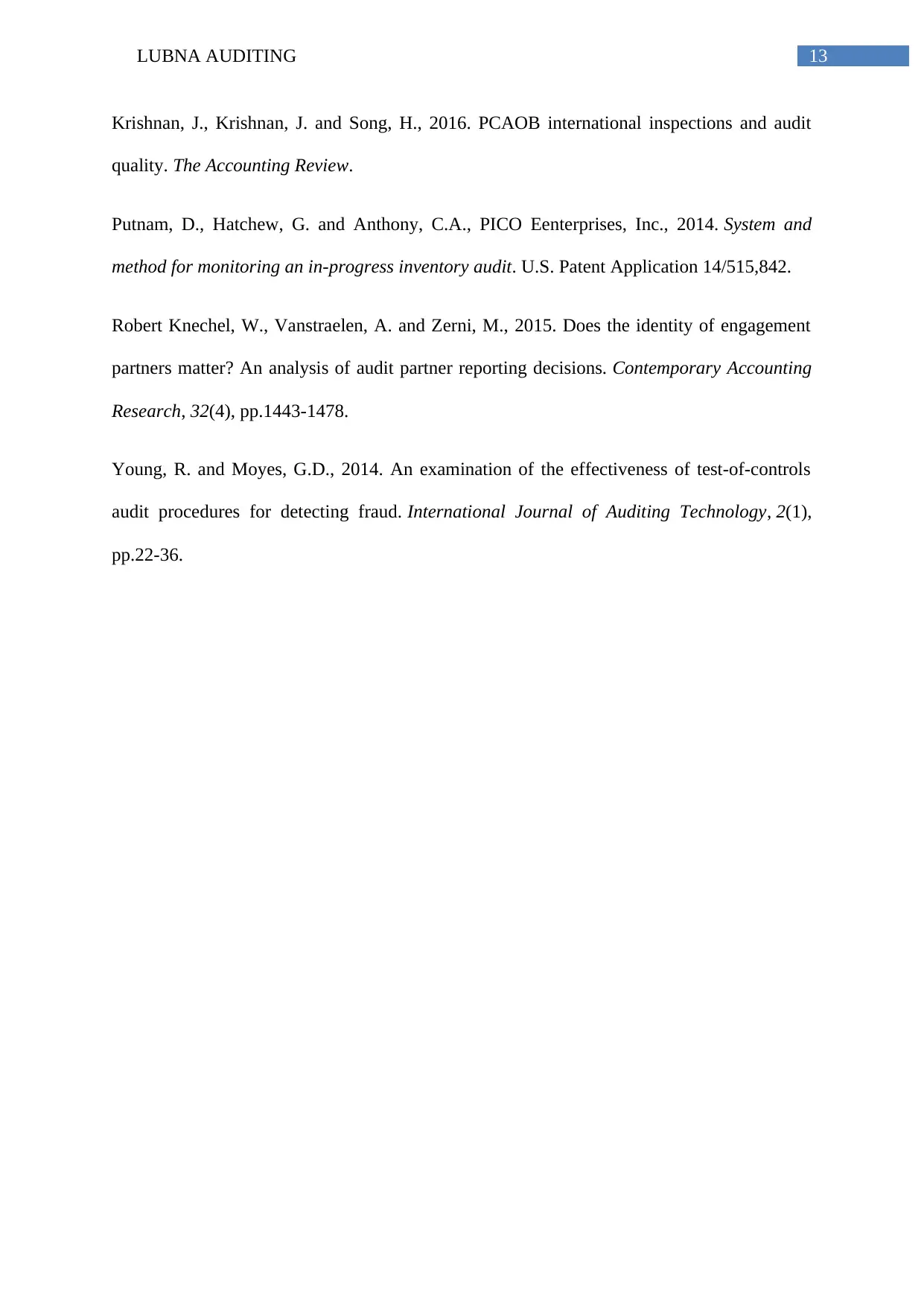
13LUBNA AUDITING
Krishnan, J., Krishnan, J. and Song, H., 2016. PCAOB international inspections and audit
quality. The Accounting Review.
Putnam, D., Hatchew, G. and Anthony, C.A., PICO Eenterprises, Inc., 2014. System and
method for monitoring an in-progress inventory audit. U.S. Patent Application 14/515,842.
Robert Knechel, W., Vanstraelen, A. and Zerni, M., 2015. Does the identity of engagement
partners matter? An analysis of audit partner reporting decisions. Contemporary Accounting
Research, 32(4), pp.1443-1478.
Young, R. and Moyes, G.D., 2014. An examination of the effectiveness of test-of-controls
audit procedures for detecting fraud. International Journal of Auditing Technology, 2(1),
pp.22-36.
Krishnan, J., Krishnan, J. and Song, H., 2016. PCAOB international inspections and audit
quality. The Accounting Review.
Putnam, D., Hatchew, G. and Anthony, C.A., PICO Eenterprises, Inc., 2014. System and
method for monitoring an in-progress inventory audit. U.S. Patent Application 14/515,842.
Robert Knechel, W., Vanstraelen, A. and Zerni, M., 2015. Does the identity of engagement
partners matter? An analysis of audit partner reporting decisions. Contemporary Accounting
Research, 32(4), pp.1443-1478.
Young, R. and Moyes, G.D., 2014. An examination of the effectiveness of test-of-controls
audit procedures for detecting fraud. International Journal of Auditing Technology, 2(1),
pp.22-36.
1 out of 14
Your All-in-One AI-Powered Toolkit for Academic Success.
+13062052269
info@desklib.com
Available 24*7 on WhatsApp / Email
![[object Object]](/_next/static/media/star-bottom.7253800d.svg)
Unlock your academic potential
© 2024 | Zucol Services PVT LTD | All rights reserved.
